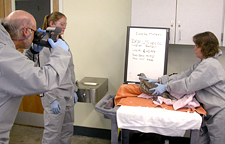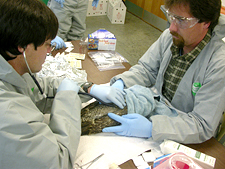For nine days, as part of a three person wash team, she washed and scrubbed more than 100 oiled birds, working 14-hour shifts hunched over tubs of soapy water.

“It’s very stressful for the birds. They don’t understand what’s happening,” says Danufsky, coordinator of Humboldt State University’s Marine Wildlife Care Center.
The center, which cleans and rehabilitates birds following oil spills, is among seven such facilities in California’s Oiled Wildlife Care Network. Funded by the California Department of Fish and Game, the 4,500-square-foot HSU facility opened in 1997 to respond to spills that hit the North Coast.
As coordinator, Danufsky stocks supplies (the preferred soap is Dawn dishwashing liquid) and maintains a database of trained volunteers. “We can be all set up and ready to take in birds within two hours. Time is of the essence,” says Danufsky, who traveled to San Francisco as part of the Oiled Wildlife Care Network.
The HSU facility sprang into action for the first time nine months after opening when, on Nov. 5, 1997, the vessel M/V Kure spilled 4,500 gallons of oil into Humboldt Bay. Oil spread throughout the bay and north to Trinidad, killing an estimated 3,950 birds. Rescuers retrieved 479 live birds — common murres, white-winged and surf scoters, dunlin and horned grebes, among many others.
“It was chaotic,” says Rick Golightly, the center’s director. Shocked residents, as well as reporters and news crews, arrived at the center in droves. Golightly, a wildlife professor, was impressed by the outpouring of concern. “People can’t go out and clean up oil because it’s dangerous. Treating birds is a way that members of the community can feel like they are doing some good.”
Cleaning birds is challenging. Workers wear protective suits, gloves and goggles to avoid contact with toxic fuel. One person holds the bird while another massages hot, soapy water through its feathers. Some birds, such as coots, thrash violently and must be restrained so they don’t cut themselves with their sharp claws. Surf scoters play dead. “It’s distressing because you are holding a bird and suddenly it goes limp,” Danufsky says.

Havoc struck again on Sept. 6, 1999, when the dredge Stuyvesant punctured its fuel tank and spilled 2,100 gallons of oil at the mouth of Humboldt Bay. The danger of spills on Humboldt Bay is especially acute because the area is relatively unspoiled and provides crucial habitat for large numbers of bird species. Workers collected 609 dead birds and 642 lives ones—mostly common murres, which had just left their breeding sites with chicks.
Surrounded by volunteers, Golightly worked 16 days straight from dawn until long into the night. “It’s hot and steamy. You’re wearing rubber clothing. There are fifty people or more in the building, and the media wants constant updates.”
Oil is deadly because it mats down a bird’s feathers, eliminates their waterproofing, reduces their ability to retain body heat and sends them into hypothermia. “On some birds, an oil spot the size of a quarter is enough to cause it to become hypothermic and die,” Golightly says.
Cleaned birds are placed in covered swimming pools to feed and recuperate before being released. About 44 percent of the birds treated following the Stuyvesant spill were released. “If we weren’t here, every oiled bird would die,” Danufsky says.
The center was activated again on Nov. 22, 2006, when oily gulls appeared on the Eureka waterfront. Rather than fuel, the culprit was improperly stored fish oil and greasy offal. “Oil is oil,” Golightly says. “It affects their feathers in the same way.”
Critics say money spent rescuing oiled birds could deliver more bang if allocated on other initiatives, but Golightly disagrees. The law says that parties responsible for oil spills must fix the damage. “We are part of that fix,” Golightly says. “And it’s also clear that this works.”
Even so, some birds are beyond saving and must be euthanized. Every species reacts differently to treatment. Endangered marbled murrelets, for instance, rarely survive. Gulls, on the other hand, have a high survival rate while about half of treated murres live to be released.
To gather more data on survival rates, Golightly is studying surf scoters affected by the San Francisco Bay spill. Airplanes equipped with tracking devices monitor the scoters via tiny transmitters placed beneath the birds’ skin. The transmitters emit a mortality signal when a bird dies, allowing researchers to retrieve the animal and determine its cause of death — whether from the effects of oil or something else.
Danufsky, who was hired in 2000 after obtaining her master’s degree in wildlife from HSU, views the Marine Wildlife Care Center as a conduit for people to channel the helplessness they feel following an oil spill. She first felt that frustration while a student in 1997, when she visited Humboldt Bay following the Kure spill. The stench of fuel filled the air. An oily sheen covered the water.
“It struck me that oil spills don’t just happen to the environment. They happen to a community. They affect all of us,” she says. “I like that I’m in a position to help.”
For more information, visit the Marine Wildlife Care Center.